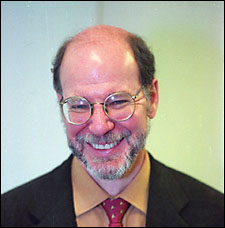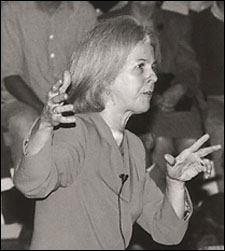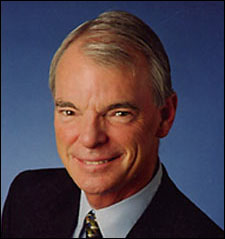Four distinguished scholars receive GSAS medal
Centennial medalists honored at Faculty Club
A mathematician who has forged new paths in algebra and algebraic geometry, a Nobel Prize-winning biologist whose work may lead to breakthroughs in the treatment of deadly diseases, a scholar of religion whose best-selling books explore the diversity of belief in early Christianity, and an economist whose groundbreaking study of markets was rewarded with the Nobel Prize received the Graduate School of Arts and Sciences (GSAS) Centennial Medal on Wednesday (June 8) at the Harvard Faculty Club.
The medalists are Michael Artin, Ph.D. ’60, mathematics; H. Robert Horvitz, Ph.D. ’74, molecular biology; Elaine Pagels, Ph.D. ’70, study of religion; and A. Michael Spence, Ph.D. ’72, economics.
Michael Artin

Artin is professor of mathematics at the Massachusetts Institute of Technology (MIT), and is one of the world’s leading algebraists and algebraic geometers. He won the 2002 Leroy P. Steele Prize for Lifetime Achievement (given by the American Mathematical Society) for his lifelong contributions to commutative and noncommutative algebra and ring theory as well as to modern algebraic geometry, including his Approximation Theorem, his work with Swinnerton-Dyer resolving the Shafarevich-Tate conjecture, and his creation of the concept of “algebraic space” generalizing “schemes.”
The citation for the Steele Prize praised Artin for helping “to weave the fabric of modern algebraic geometry” and for contributing “spectacular results in classical algebraic geometry.” It also noted that “for 20 years he has worked to create and define the new field of noncommutative algebraic geometry.”
Artin is the editor or author of several books, including most recently “Algebra” (1991), “Arithmetic” (with John Tate, 1983), “Arithmetic Geometry” (with Gary Cornell and Joseph H. Silverman, 1986), and “Duration and Change: Fifty Years at Oberwolfach” (with Hanspeter Kraft and Reinhold Remmert, 1994), a collection of essays on Germany’s renowned mathematical institute.
H. Robert Horvitz
Horvitz is the David H. Koch Professor of Biology at MIT, where he has taught since 1978, and an investigator with the Howard Hughes Medical Institute. He served as president of the Genetics Society of America in 1995.

Horvitz shared the 2002 Nobel Prize for physiology with Sidney Brenner and John E. Sulston for groundbreaking work on “death genes.” Horvitz discovered and characterized key genes controlling cell death in C. elegans, a species of nematode much studied by biologists because it shares many characteristics with humans. He has shown how these genes, known as ced-3, ced-4 and ced-9, interact with each other in the cell death process and has also demonstrated that corresponding genes exist in humans. His work has transformed our knowledge of programmed cell death from something fairly obscure to a precisely delineated process.
These discoveries on cell death are being applied to medical research into cellular diseases, such as cancer and amyotrophic lateral sclerosis (Lou Gehrig’s disease). Because cancers arise because of abnormalities in cells, researchers would like to find more information about this unique system of “cell suicide” in order to attack and induce death in malignant cells.
Elaine Pagels
As a graduate student at Harvard, Pagels became part of a team of scholars who studied the Nag Hammadi manuscripts, a collection of Coptic writings unearthed in Egypt in 1945. These writings are believed to date from the fourth century A.D., but to reflect texts and traditions as old or older than the Gospels of the New Testament.

Pagels’ 1979 book “The Gnostic Gospels,” based on her work with the Nag Hammadi texts, demolished the popular assumption that early Christianity was doctrinally homogeneous and became corrupted by heresy during later eras. Judging from these early texts, early Christianity embraced a wide range of beliefs and practices, some of which even the most liberal Christians of today might consider dangerously “New Age.” The book sold 400,000 copies and won numerous awards and acclaim.
Pagels joined the Princeton Department of Religion in 1982 and is now the Harrington Spear Paine Professor of Religion. Among the fellowships she has received are the Rockefeller (1978-79), Guggenheim (1979-80), and MacArthur (1980-85). Her later books include “Adam, Eve and the Serpent” (1988), “Images of the Feminine in Gnosticism” (1988), “The Origin of Satan” (1995), and “Beyond Belief: The Secret Gospel of Thomas” (2003), which remained on The New York Times best-seller list for 19 weeks and was nominated for a Pulitzer Prize. Pagels has published widely on gnosticism and early Christianity, and continues to pursue research interests in late antiquity.
A. Michael Spence
Spence is the Philip H. Knight Professor Emeritus and former dean of the Stanford University School of Business. He won the Nobel Prize for Economics in 2001 (with George A. Akerlof and Joseph E. Stiglitz) for work on the dynamics of information flows and market development. Spence is probably best known for his job-market signaling model, which essentially triggered the enormous literature in this branch of contract theory.

In 1983 he was named chairman of the Harvard Department of Economics and George Gund Professor of Economics and Business Administration. While at Harvard, Spence was awarded the John Kenneth Galbraith Prize for excellence in teaching and the John Bates Clark medal for a “significant contribution to economic thought and knowledge.”
From 1984 to 1990, he served as the dean of the Faculty of Arts and Sciences at Harvard, overseeing Harvard College, the Graduate School of Arts and Sciences, and the Division of Continuing Education. He later served as dean of Stanford Business School from 1990 to 1999. Spence is a fellow of the American Academy of Arts and Sciences.




